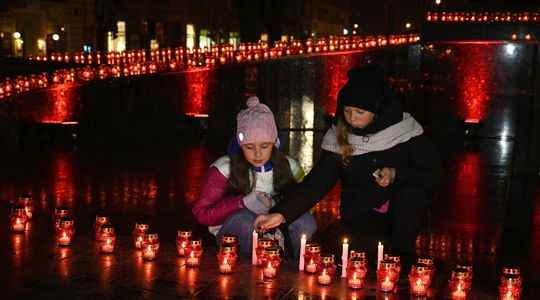With slow steps, punctuated by moving traditional music, the Ukrainian president approaches a statue representing a cadaveric little girl, in order to place at her feet a flowered candle of holly, a plant symbol of strength and resistance. A week ago, Saturday November 26, Volodymyr Zelensky commemorated, in kyiv, the 90th anniversary of the greatest massacre ever perpetrated against Ukraine: the Holodomor. A term with a sound from beyond the grave, which means, in Ukrainian, “extermination by hunger”. “The number of Ukrainians who died during this great famine far exceeds the total of Ukrainian Jews killed in the Holocaust by bullets between 1941 and 1944,” said Galia Ackerman, a historian specializing in post-Soviet Russia. For the crime perpetrated by the Nazis, the estimate rises to 1.5 million Ukrainians murdered. For the one committed by the USSR, the total would be between 4 and 6 million people.
The Holodomor is the macabre result of a policy of terror led by Stalin from the end of the 1920s, when he launched the forced collectivization of land, putting an end to all forms of private property. Henceforth, the peasants work in large collective farms, the kolkhozes. “At that time, wheat was essential to the smooth running of the Soviet economy, explains Galia Ackerman, since the USSR exported it massively in order to earn the currencies necessary for the development of its industrialization”. Collection quotas are set by the Kremlin, but they are unrealistic. In Ukraine, local officials and farmers are expressing their dissatisfaction. The former are victims of purges, the latter starved according to a well-defined plan. “The Soviet regime draws up a list of villages to loot, notes the founder of the Desk Russia site. Then special detachments are sent to recover all the food sources present: seeds, livestock, canned food… When they leave, they don’t nothing left to eat.” And that’s not all. The inhabitants of these villages are watched, so that they cannot leave a certain perimeter, which will be their cemetery.
An extermination deliberately targeting Ukraine
In historical vocabulary, the intentional process of annihilating a population, an ethnic or religious group is called genocide. For the Ukrainians, there is no doubt that the Holodomor is one. On November 28, 2006, the Ukrainian Parliament voted for this qualification, but few European countries have done the same. Let us quote Spain and Italy, let us exclude Great Britain and France. The characterization of genocide is often problematic, and there is a debate among historians, some arguing that the famine affected other regions of the USSR – notably the South Caucasus and Kazakhstan – and that it is impossible to affirm that a deadly operation directly targeted Ukraine.
For Galia Ackerman, this position, which happens to be that of Russian historians, does not hold: “There are letters exchanged between high Soviet dignitaries and Stalin himself, where it is written that, in order to hold Ukraine under the yoke of Moscow, the extermination of its inhabitants is necessary”. By massacring the Ukrainian people, the project is clear: it is a question of destroying their identity. And the peasants, great bearers of traditions, are its best representatives. Denying the existence of Ukraine as an autonomous entity of Russia is a subject that brings us back to the present. In the footsteps of Stalin, Putin also intends to erase all particularism by death. And it doesn’t matter that Ukraine has been a sovereign state since 1990.
The commemoration of the Holodomor has a special dimension in these times of war. “Ukrainians are living through a contemporary version of the Holodomor, observes Gallagher Fenwick, great reporter and author of “Volodomyr Zelensky: Ukraine in Blood” (Editions du Rocher, 2022). Russia pursuing, by d other means, his genocidal enterprise against Ukraine.” Because if no famine can be orchestrated today by the Kremlin, the latter has chosen to sow terror by bombing hospitals and destroying energy infrastructures, with the aim of plunging Ukraine “into darkness and cold “, in the words of Zelensky. Until it breaks down.
Ukraine, again “a land of blood”
But the Ukraine of 2022 has strong support, and the Ukrainian president intends to bring the Holodomor into the minds of his allies, to show them what Russia is capable of. “Volodymyr Zelensky speaks first to his people, who carry this traumatic event in their hearts,” explains Gallagher Fenwick. But, of course, it is also addressed abroad, because mourning is only possible if the suffering is recognized by others”. The Belgian Prime Minister, Alexander de Croo, has, in this sense, participated to the tribute of November 26, when Germany recognized, the next day in the Bundestag, the Holodomor as being a genocide.
Words have meaning, and sometimes the weight of a weapon. “By recognizing the term genocide, the allied governments of Ukraine are participating in what can be called the defense of memory, indicates the former English-language editorial director of France 24, Gallagher Fenwick. This makes it possible to oppose the truth to the rewriting of history that Putin is implementing”. As in the 1930s, Ukraine is once again “a land of blood”, in the words of American historian Timothy Snyder. But from the terrible ordeals, she drew a certainty, which Zelensky proclaimed like a slogan in front of the Holodomor memorial: “We cannot be broken.”
